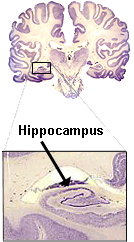 | More Good News for Aging Brains |  |
 | More Good News for Aging Brains |  |
|
By Ellen Kuwana Neuroscience for Kids Staff Writer November 16, 1999
Progress Research in animals such as rats,
lizards, and birds has shown that new neurons are produced in the part of
their brains called the hippocampus. This production of new neurons is
called neurogenesis. It was a logical step for
scientists to suspect that neurogenesis might also occur in adult humans.
They were correct. Research in animals such as rats,
lizards, and birds has shown that new neurons are produced in the part of
their brains called the hippocampus. This production of new neurons is
called neurogenesis. It was a logical step for
scientists to suspect that neurogenesis might also occur in adult humans.
They were correct.About a year ago, research showed that new neurons were produced in the hippocampus of human brains. Now scientists are looking at parts of the brain to see if new neurons are produced there, too. To look for new neurons, researchers use a chemical called bromodeoxyuridine, or BrdU for short. BrdU is incorporated into new cells, thus making them distinguishable from old cells. When researchers examine brain tissue, they can look for cells that contain BrdU.
|
| There is some
evidence that the new cells are functional. The
cells originated in the subventricular zone, an area around the ventricles, the
fluid-filled cavities deep within the brain. These cells then migrated
from this area to the cortex, where they developed axons. The fact that
the new cells formed axons suggests that they are functioning. This new study indicates that neurogenesis in the brain is more widespread than previously thought. If researchers can find out how new neurons appear, what conditions are necessary for generating new neurons, what factors need to be present or what chemicals must be absent, perhaps this information can be used to fight neurodegenerative diseases. Answers to these questions may provide treatments for disorders such as Alzheimer's disease and Parkinson's disease. |
 The Ventricles Image adapted from Biodidac |
|
References:
|
| BACK TO: | Neuroscience In The News | Table of Contents |
![[email]](./gif/menue.gif) Send E-mail |
![[survey]](./gif/menusur.gif) Fill out survey |
![[newsletter]](./gif/menunew.gif) Get Newsletter |
![[search]](./gif/menusea.gif) Search Pages |
![[notes]](./gif/menunot.gif) Take Notes |